My friends, my friends! If you have been embroidering for even a little while, you’ve probably encountered metallic threads.
And if you’ve encountered metallic threads, you’ve probably encountered the Unending Frustration that goes with them!
For hand embroidery, metallics are always problematic, it seems – more so when you’re doing surface embroidery, free of a grid with open holes like those provided by needlepoint canvas or counted cross stitch fabric. When you’re embroidering on a fabric with a closely-woven surface, like a high count linen, cotton, or silk, metallics are not friendly.
In fact, they’re normally pretty darned cranky.
Today, I’m going to show you metallic threads you will actually want to use, whether you’re doing surface embroidery, counted work, or needlepoint!
These metallics are well-behaved, compared to other metallics widely available on the needlework market. In fact, they are actually a pleasure to stitch with. And when you’re talking about a metallic thread, that says a lot!
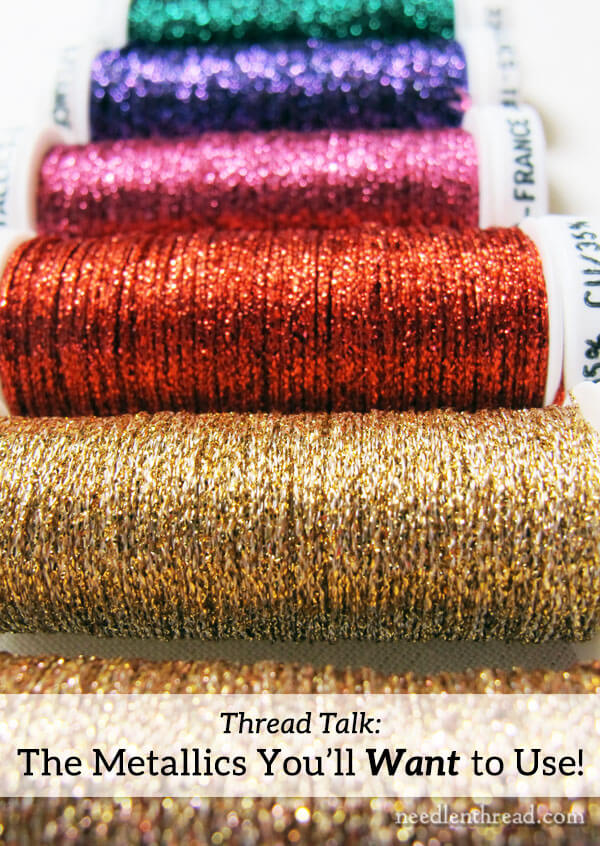
A long time ago, back in the early days of my adulthood, when I was barely no longer a youth, I began exploring “goldwork” – only I had no idea where to find goldwork threads (this was pre-internet), so I used metallic threads.
In fact, there was only one metallic thread available to me at the time. It was not a very happy experience!
It surprises me even now, when I look back, that it didn’t put me off embroidery forever.
But it did put me off metallics for a long while, and I’ve had a hard time getting over that. Still, if you like sparklies (I do!), and if you are enamored with threads in general (I am!), it doesn’t take long to start glancing at metallics again, even if you’ve been burned by them once or twice. There’s always the hope that something will have changed.
Are All Metallics Equal?
And though the thread industry has come a long way with all kinds of new threads and wonders on the market, I still find the metallics commonly available troublesome, irritating, and frustrating in some way or another. I’ve not found one widely available metallic thread that I really love – that I find pleasurable to stitch with – but there are a few that I’ve tolerated when I’ve wanted the effect of metallics in a design.
And that’s The Thing about metallics. It seems, with many stitchers (and even some designers), that we freely admit frustration when working with metallic threads. We adopt all kinds of little hints and tips to try to achieve a successful result, and we soldier through, hoping for success, because we want the outcome.
Use Thread Heaven! (a silicone-based thread conditioner).
Use a laying tool!
Cut short lengths!
Cut very short lengths!
Use a Really Big Needle.
Iron it! (Or run it through a flat iron.)
This is just some of the we’re given when working with metallics, because, after all, isn’t that just the nature of the thread?
Aren’t all metallics made equal, equally frustrating in one way or another? Isn’t the frustration something we just have to put up with?
And so we employ any extra effort necessary, to help reduce that frustration.
On that grounds, you can guess how it is: some stitchers forego the sparkle completely, because, really, who needs the frustration?! Embroidery, after all, shouldn’t be about frustration!
THAT Metallic Braid
Several years ago, I tried a metallic braid – a rather hefty one, as embroidery threads go – that changed my view on metallics.
That’s when I discovered that all metallics are not equal.
The spool was marked as Au Ver a Soie, and the braid was a size 16. I used it to play around with some braid stitches.
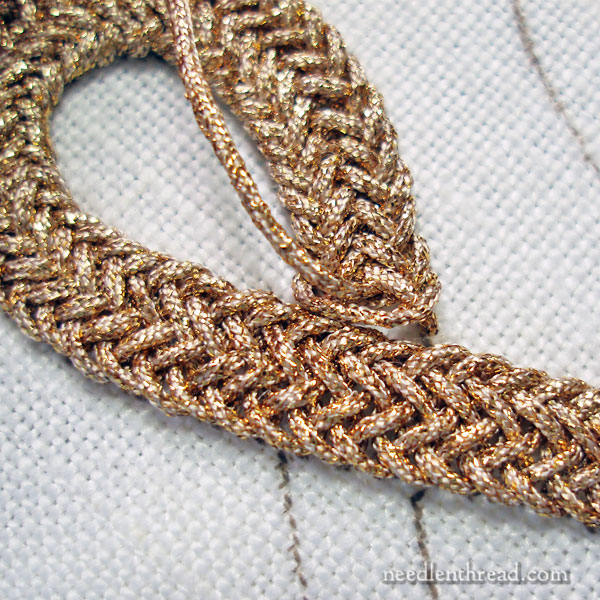
Specifically, I tried it with plaited braid stitch…
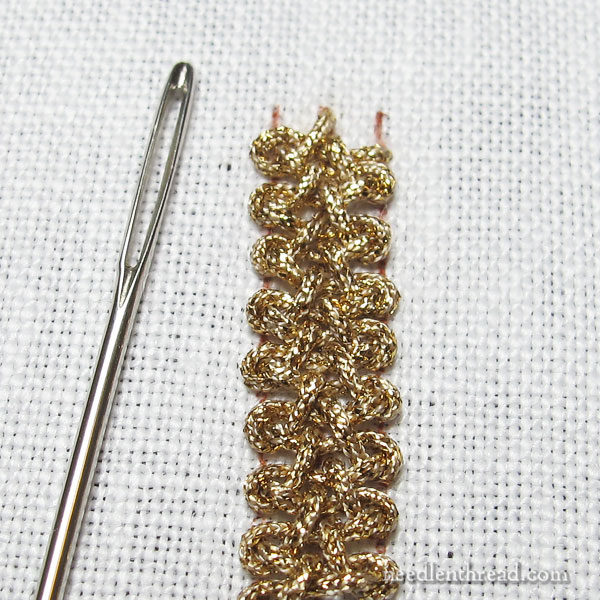
…and with Spanish knotted feather stitch, worked close.
It worked well!
In fact, it worked magnificently!
In fact, it was a pleasure to stitch with!
Unlike other metallics, when this thread passed through the fabric, the metallic fibers didn’t break, causing the thread to knot or bunch, even after repeated stitching.
The thread didn’t twist – it was very supple. It did just want I wanted it to do, and behaved just as a good thread should.
But it wasn’t available on the US market, and I had no desire to design anything with metallics, so I didn’t really think about it again…much.

Recently, though, I’ve been thinking about incorporating metallics on a project that I’m concocting, that requires a little zing to make it work the way I want it to.
Remembering my success and pleasure with the Au Ver a Soie #16 braid, I reached out to Au Ver a Soie to find out more about their braids.
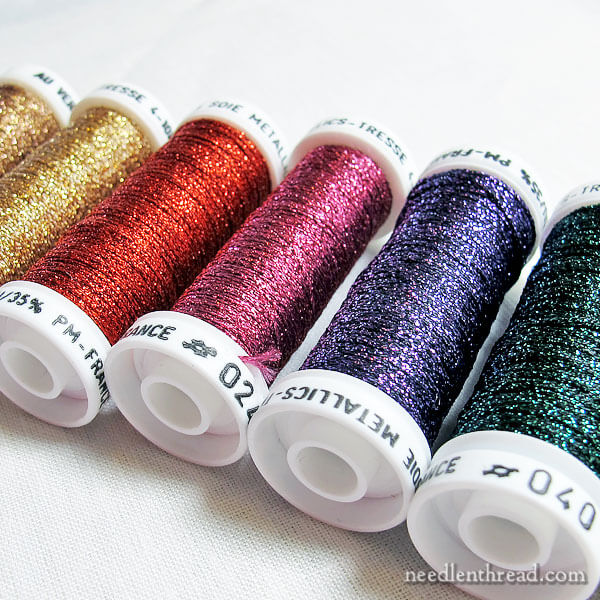
Au Ver a Soie is a silk thread company in France that’s best known here for their gorgeous line of high quality silks for hand (and machine) embroidery. And – wow! – to my surprise, they also produces a fairly vast line of metallic threads. Did you know that? I knew they had the one braid, but I didn’t realize they had a Whole Line of metallic threads in various sizes, in some 150 (one hundred and fifty!) colors.
But now I do!
I’ve tried three of the weights (thicknesses) of the metallic braid – 4, 8, and 16.
I’m convinced that, if all metallic threads behaved the way these braids behave, stitchers wouldn’t suffer from MTD (Metallic Thread Discontent).
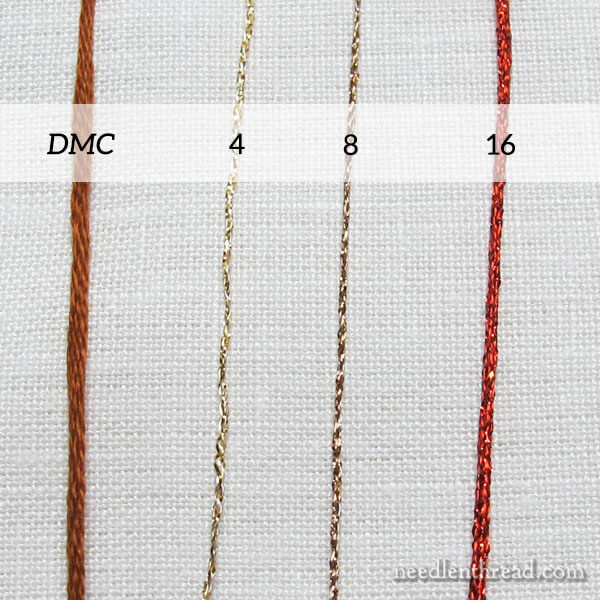
In the photo above, you can get a good idea of the size of three of Au Ver a Soie’s metallic braids.
On the left, for comparison’s sake, is a full strand (all six) of DMC cotton floss.
The next thread to the right is the metallic braid #4, which is the finest size. The #8 is about twice as heavy. And the #16 is about twice as heavy as the 8, and stitches up slightly heavier than the full six strands of DMC.
With these braids, it’s easy to stitch real embroidery stitches on closely woven fabric. They don’t crumble, crinkle, snaggle, tangle, knot, twist or break in the process, despite the fact that they’re traveling through closely-woven fabric repeatedly.
To demonstrate, I worked up a bit of stitching for you.
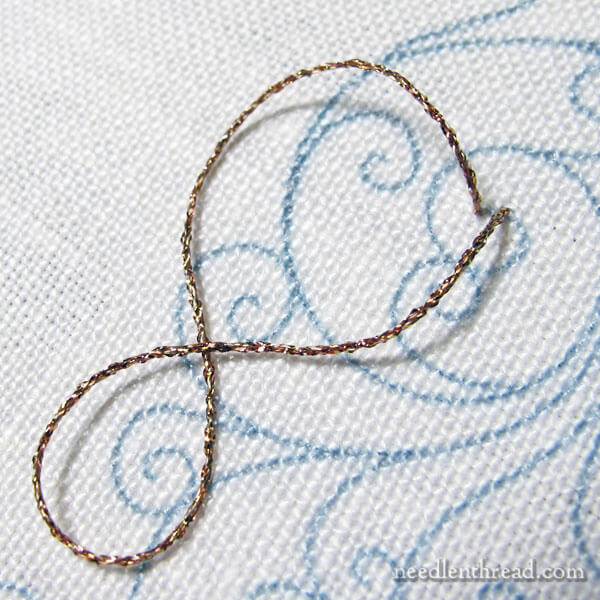
Using a reduced version of this scrolly design (it’s 3.5″ wide on the fabric), I stitched a few scrolls with the metallic braids.
I started with the #8.
Do you see how the braid has turned itself into a figure 8 in the photo above? That’s the one and only time the thread “twisted” while I stitched with it, and that was the extent of the twist. As I pulled the thread through, it straightened itself up and moved right through the fabric.
Sure, there’s a different feel and sound when metallics pass through the fabric. But with these braids, there was no hang up, no snarling as I stitched.
I used a stem stitch on this little demo piece…
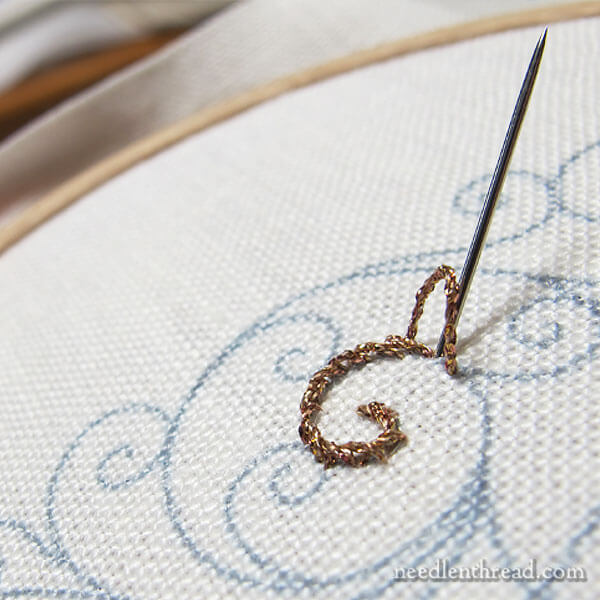
…which is not generally a metallic-thread-friendly stitch.
But it worked!
Notice that, on the fabric all around the stitching, you don’t see any metallic speckles or any remnants of slivers of thread that have broken off. You also don’t see any discoloration on the fabric around the stitches, which can happen with some metallic threads.
On the braid, you don’t see any significant spaces of separation between the metallic filaments, either, where the core thread shows through a lot. This often happens on metallic threads, either due to breakage or just shifting of the metallic filament.
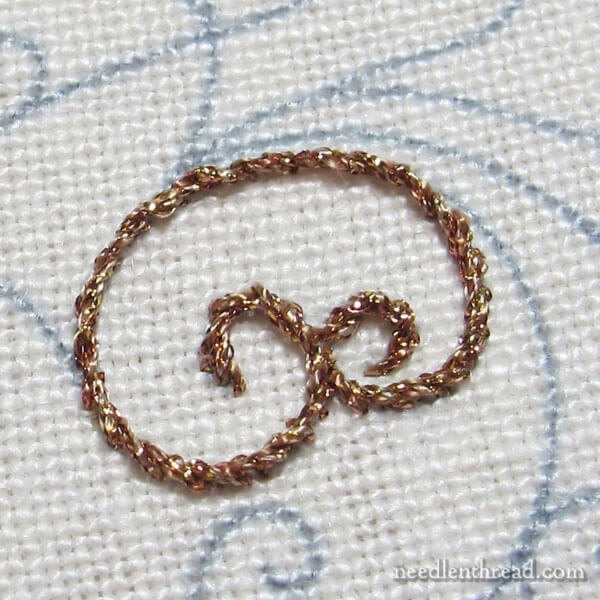
Why, hello there, little curlicue!
See? The thread survived!

Next up, I worked a curl with the #4, which is the finest braid.
The #4 is not as “heavily” braided as the #8 – there isn’t as much metallic around the core as there is on the 8 – but it still holds up very well to stitching. Again, no twists, snags, breaks, knots…
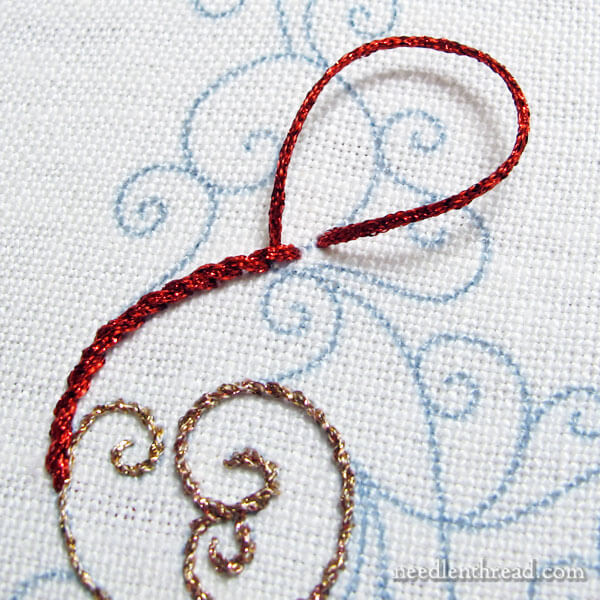
…and so I moved on to the #16, which is, in fact, a rather massive braid all things considered, and because of its size, I wasn’t expecting it to hold up well to stem stitch.
But guess what?
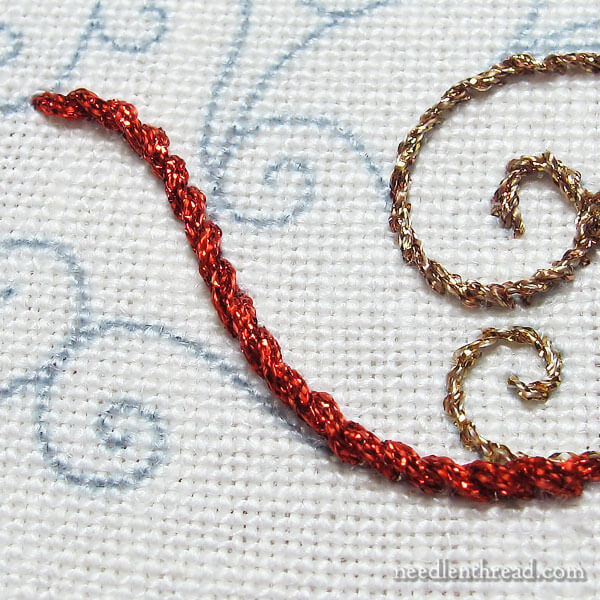
It not only held up, but it held up beautifully.
I didn’t encounter one moment of frustrated stitching, either. I just started stitching, stitched the stitches, and I stopped stitching, just like I would with any thread.
I didn’t use a laying tool. I didn’t use a thread conditioner. I didn’t iron the threads or run them through a flat iron. I didn’t do anything other than work through the steps of the stitches.
One of the frequent tips for working with metallics and reducing frustration is to work with very short lengths of thread. In some cases, I’ve heard of folks who advise 12″ or shorter. I’ve even come across kit instructions that say to cut 10″ lengths. Once they start showing wear or begin to break down, you should switch the thread.
With the Au Ver a Soie braid, I cut all of the braids at 18″ which is about the length I use for regular floss. I never had to stop stitching for breakage or signs of wear.
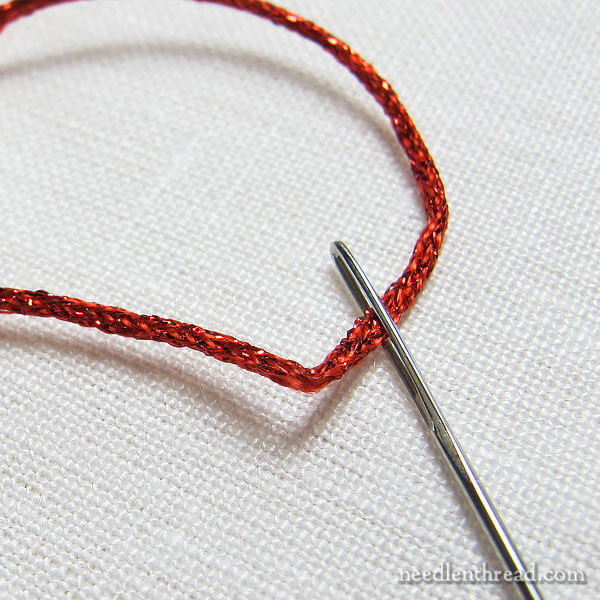
The telltale sign of metallic thread breakdown often starts at the eye of the needle. Here, you’ll normally find broken metallic filaments that catch and buckle as the thread passes through the fabric.
Above, you can see the #16 in the eye of the needle, and the crease where it was folded in the eye. Yes, there’s some wear – that’s expected with any thread – but notice that there’s no broken metallic filaments. No bunched metallic filaments. No little knotty bits.
What a champ of a thread!
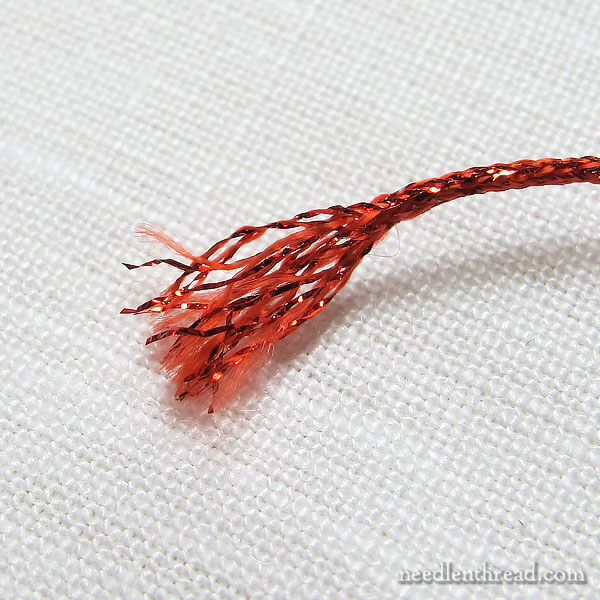
The short end of the thread by the eye fuzzed out a bit, as any thread will. But it’s still in great shape – nothing missing, knotted, kinked up or broken down.
Now, if every metallic thread behaved like these, I’d probably be in trouble. I’d probably have a hefty stash of metallics.
These are wonderful braids to work with! And if they work this well on closely-woven linen, imagine how comfortably they’d be to use on counted cross stitch fabric and needlepoint canvas!
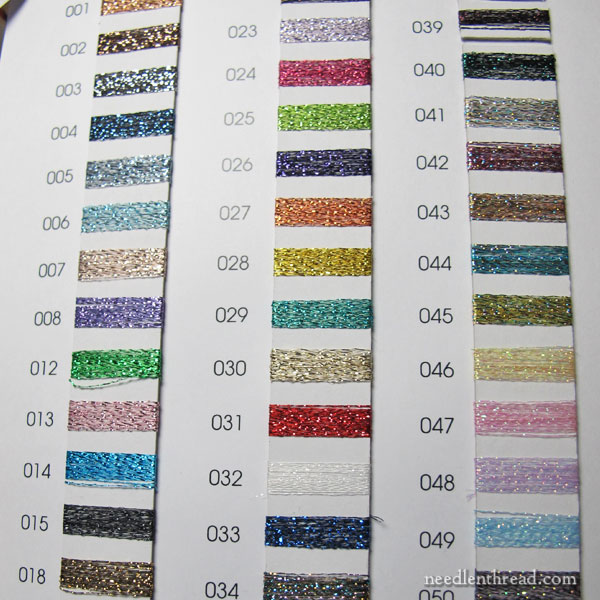
This is just one page of Au Ver a Soie’s color card for their metallics, showing the solid colors. With the project I have in mind, the dark blues, greens, and blue-greens that are somewhat reminiscent of a peacock are what I’m honing in on.
Not that I’m stitching a peacock, mind you! But gosh, now that I think about it…!
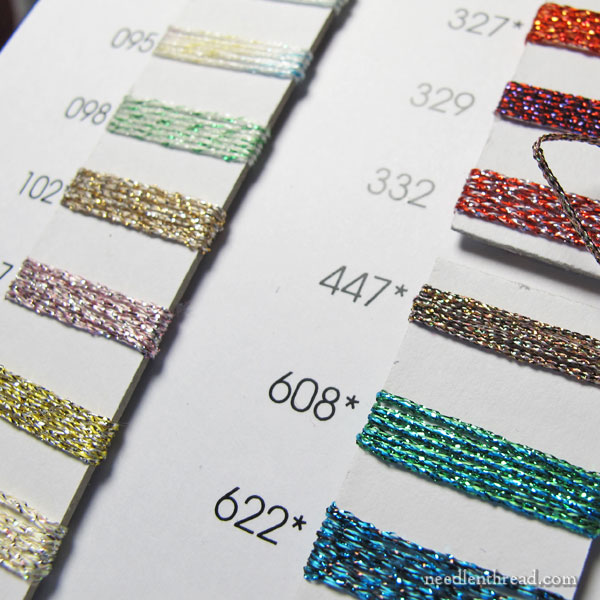
*Sigh.* The mixed colored braids are delectable!
Where to Find Them
One of the reasons I suppose folks in the US don’t work with Au Ver a Soie’s metallics more often is that… alas and alack!…up to now, they haven’t been available here.
I can’t help thinking that perhaps the problem is that more stitchers don’t know about them. After all, if you knew that there are metallic thread that offer a much less frustrating stitching experience, with a wide range of colors in different weights…wouldn’t you want to use them?
I figure that, if you pour your heart and soul into your stitching, then you deserve beautiful and easy-to-use metallics.
If you’re not in the US, but you have a shop that sells Au Ver a Soie goods, chances are, they either have these braids, or you can request a special order.
In the US, right now, there are a few Au Ver a Soie metallics available through Needle in a Haystack, here, if you want to try them. If there’s an interest in other colors, let them know! It would be nice to see a more extensive range available, wouldn’t it?
These are surely the best metallic threads for surface embroidery on the market today. I’m convinced that, if you stitch with metallics, Au Ver a Soie’s braids will change your needlework game entirely!
I hope you try them!